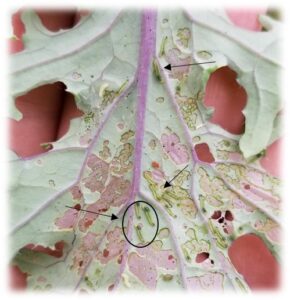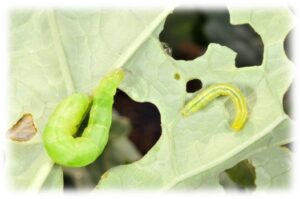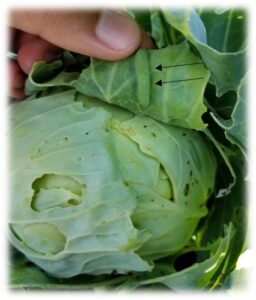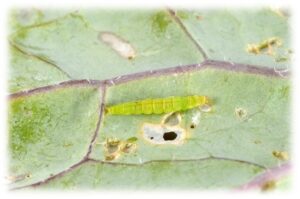I really thought I was staying ahead of the insects in my crucifer greens pretty well, but as you can see from my ravaged arugula plant (Figure 1), I was wrong!
It’s that time of year again when holes may be appearing in your favorite crucifer crops, including cabbage, broccoli, cauliflower, kale, arugula, Brussel sprouts…and the list goes on! Although there are several insect culprits that may be causing damage, caterpillars are key pests to be vigilant for.
Whether you have fields or a small garden of delicious cruciferous greens, caterpillars are the primary pests to manage; if you don’t stay ahead of them, they can devastate your crop. In Indiana, the three most common caterpillars you’ll find eating your crucifers are the imported cabbageworm, cabbage looper, and the diamondback moth. All three caterpillars feed on the leaves and heads of developing crucifer plants, reducing plant growth and leaving behind large holes (Figure 2) and crop-fouling frass (insect excrement) that make crops unmarketable.
Of these three very hungry caterpillars, the cabbage looper eats the most foliage during its development. Cabbage looper caterpillars are light green with a white stripe on each side of the body and reach a maximum size of ~1.5 inches (Figure 2). The imported cabbageworm is a green, slightly fuzzy caterpillar with a yellow stripe down the back and reaches ~1 inch in length when mature (Figure 3). Diamondback moth caterpillars are a pale greenish-yellow color and the smallest of the three species, reaching a size of just a third of an inch when mature (Figure 4). These small caterpillars are notorious for dropping off the plant and dangling from a silken thread when disturbed.
While most crucifers can withstand significant amounts of feeding with no impact on crop yield, it’s important to be mindful of where the feeding damage occurs and whether that is the marketable part of the crop. For example, cauliflower and broccoli can tolerate caterpillar feeding on the leaves, but any feeding on the heads can render these crops unmarketable. Conversely, in turnips grown for the greens (rather than the root), collards, and mustard greens, the leaves are the marketable parts that must be protected.
Scout your plants regularly so you catch infestations before they become damaging. See the “Caterpillars” section of “Managing Insect Pests of Commercially Grown Crucifers” and the Midwest Vegetable Production Guide for Commercial Growers (https://mwveguide.org/results/pest/3279/crops/566,567,569,571,574,573) for more detailed information about action thresholds for each caterpillar species, as well as organic and conventional insecticide products that target these pests. And always remember there are good insects in your crops too, like damsel bugs (Figure 5) that may be feeding on the eggs and caterpillar stages of these crucifer pests!
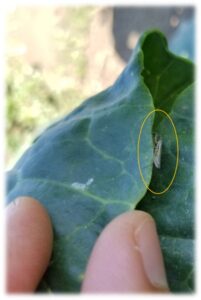
Figure 5. A beneficial insect, commonly known as a damsel bug, searching for caterpillar prey. Photo by E. Y. Long.
